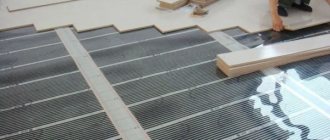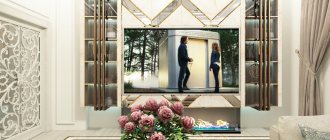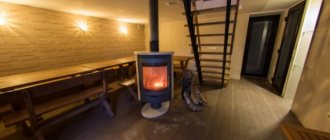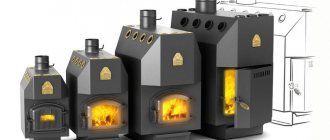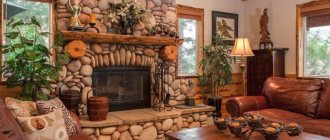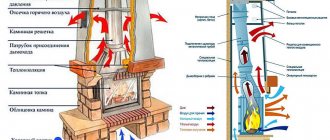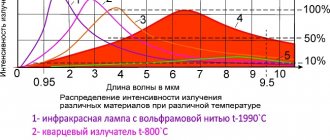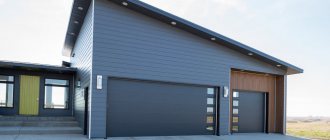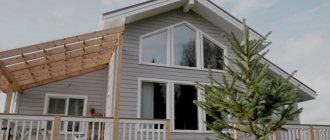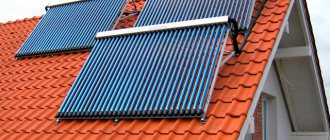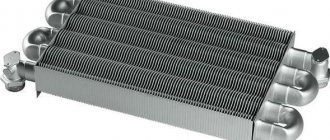A real fireplace is synonymous with comfort. There is nothing more pleasant than sitting in a rocking chair under a warm blanket on a winter evening, with a mug of hot tea or cocoa, and looking at the crackling logs behind the carved fireplace grate. But the fireplace also has a practical side - in addition to getting pleasure from contemplating the flames of the hearth, you can use the fireplace to heat the house as an additional source of heat. How to properly arrange a fireplace in a private home so that it not only pleases the owners with its appearance, but also effectively warms us, we will figure it out in this article.
What is a fireplace?
A fireplace is a type of stove that generates heat by burning solid fuel. The classic option is firewood, just like a regular wood-burning boiler, but you can heat the fireplace with coal, and special briquettes or pellets. Fuel burns due to air draft created by the design of the fireplace. The blower channel ensures the flow of cold air into the main chamber where combustion occurs. The smoke goes into the smoke collector and is then discharged through the chimney, providing sufficient draft for the active combustion process of wood. The resulting heat is distributed throughout the house depending on the design of the fireplace.
The fireplace consists of four main parts:
- Portal. This is the external, frontal part of the fireplace, which has both a structural and decorative function. It can be made of brick, natural stone, marble, artificial stone. The portal is decorated with various decors; it can be made in any style that suits the interior of the house. The upper part is used as a mantelpiece.
- Firebox. This is the central part of the fireplace, the chamber in which fuel is burned and heat is produced for heating. To make the firebox, fire-resistant metal or heat-resistant brick is used. It may be open or have a door.
- Hailo (smoke collector). Only needed for fireplaces with an open firebox. It is a special chamber where smoke is collected before entering the chimney.
- Chimney. A vertical pipe for removing smoke outside the house, providing draft for active combustion of fuel in the main chamber of the fireplace.
If in your home there are restrictions related to the organization of the chimney or you are put off by the need to prepare firewood for a wood-burning fireplace, you can opt for a bio-fireplace. You can buy a fireplace that does not require burning wood to operate on the Biokamin.rf website. There you can also find traditional solutions in various configurations.
The fireplace has several varieties, each of which has its own design features, and therefore fireplaces are classified according to several criteria.
Types of closed fireplaces
If we put aside all the decorative elements, the main component of a modern fireplace is the fireplace cassette, which is produced in a factory. The cassettes have a door with glass, adjustment handles, and a chimney pipe. Fireboxes are made of steel and cast iron, lined with fireproof plates.
Different models require additional accessories such as:
- Smoke collector;
- Secondary combustion chamber;
- Convective channels;
- Thermal jacket;
- Water heating circuit.
In addition to built-in fireplace cassettes, there are also ready-made fireplace stoves on sale.
Types of fireplaces for home heating
First of all, fireplaces are distinguished by the type of combustion chamber device:
- Open fireplace. This is a decorative option for a heating structure - a fireplace without walls looks beautiful, but its efficiency is low, it only heats the room in which it is located, and only partially if the room area is large.
- Semi-open fireplace. It is attached to the wall or recessed into it; one of the walls is missing, which allows you to observe the combustion process. The heat transfer potential of this design is already higher; it can be used as a full-fledged additional source of heating for the house.
- Closed fireplace. In the vast majority of cases, this is a fireplace built into the wall, separated from the room by a metal damper or heat-resistant glass. This is the safest fireplace option in terms of fire hazard and the most efficient fireplace option in terms of thermal potential. Such a fireplace stove is quite suitable for heating a house even as the main source.
In order to use a fireplace as a source of heating for a home, it will need a distribution system that will distribute the heat throughout all the rooms. On this basis, fireplaces are divided into two groups: with water heating and with air heating.
Fireplace with air heating
These are closed type fireplaces in which there is no direct contact with the room air. The fireplace design includes air ducts that distribute heated air throughout the house. Both natural and forced distribution of hot air throughout rooms can be used to increase efficiency. Such fireplaces come in both floor-standing and built-in types.
Natural convection circulation of flows is effective for heating only one room. To heat several rooms, forced injection of hot air is necessary. This is done using built-in fans powered by electricity. Air ducts lead to each room, which is supposed to be heated using a fireplace.
Fireplace with water heating
Fireplace heating of a private house can be organized using a fireplace with a water circuit.
This fireplace is connected to the radiator water heating system of the house. As an additional functionality, it has a hob. There are such varieties as fireplace stoves with a water circuit made of cast iron and other metals.
A fireplace with a heat exchanger can be used as a spare, backup method of heating a country house, for example, when using a gas boiler as the main source. Such a fireplace can be used without heating water for heating, which can be important in the summer.
Forced air systems
Forced air heating means that the heated air is first forced into the convection chamber and then moved into the rooms using a single or several duct fans. In this case, heat can be transported no further than 10 meters. In this case, it is permissible to use air ducts of small cross-section, as well as flexible ventilation ducts.
This method of heating with wood-burning fireplaces for a private home allows you to uniformly provide heat to all rooms, while filtering and humidifying the warm air. But this heating option has disadvantages. The main one is the noise made by fans. Also, forced-pressure systems do not function without a power source.
Comparison of air and water type fireplaces
Let's compare two types of fireplaces according to the main parameters:
Which fireplace heats a room faster? Here the air fireplace takes precedence: hot air enters the rooms immediately, but heating the water takes time.
Which fireplace will provide longer heating? The water circuit wins here: radiators give off heat for some time after the fuel has burned out, and an air fireplace stops heating immediately.
Which system is cheaper? A fireplace with an air circuit is cheaper, and if desired, you can install the air ducts yourself, unlike a radiator heating system at home.
Water heating system
Another idea for heating with a fireplace is that there is no need to transport air to a room located at a distance. The heat capacity of air is small and it can significantly reduce its temperature until it reaches the desired location through the air duct. You can use an intermediate link - water. Due to its large heat capacity, it retains heat for a long time and can provide a transport function for energy.
The principle of operation of the water system
Then the fireplace for heating the house must have a heat exchanger or circuit and serve as a connection to the heating system. The radiators known to us will play the role of secondary heat sources in each room and heat the air.
In most versions, the heating system is open. This means that atmospheric pressure is created above the liquid and the highest point is an expansion tank. This design allows you to use the fireplace as a full-fledged boiler. But this system has a drawback - the temperature of the coolant is limited by its boiling point.
The fact that with increasing pressure the boiling point rises is used in closed systems. This increase in pressure is caused by thermal expansion of the liquid. A special pump is used for circulation. A heating fireplace with a circuit can operate on wood or gas. But it has one more important useful property. If the circuit is connected to the water main, the energy of the fuel will be transferred to the water. It can be used for bathing or washing dishes.
Good to know: Wood-burning fireplaces for the home, the main advantages of using such devices
Fireplaces with water cloaks
These devices have one distinctive feature, namely: a two-layer firebox body, between the individual layers of which heated water circulates. The latter is supplied to heating radiators through specific pipelines. If at the same time you install a coil in the upper section of such fireplaces, you can not only heat the rooms, but also get constant access to hot water for domestic needs.
Such heating elements have a manual operating principle based on increasing or decreasing the amount of air entering the firebox. It is possible to establish automatic adjustment, which is done through the additional installation of thermostats equipped with pumps.
Subtleties of personal fireplace construction
We offer several practical recommendations regarding the desire to make a fireplace without the help of a professional stove maker:
- The firebox must be mounted on a specially made stone or brick platform.
- Only after this is it allowed to install the portal itself and connect the air ducts.
- All systems are covered with plasterboard sheets.
- Air ducts are laid in all rooms, and even in the attic.
- The main unit of the entire air exchange system should be placed in a technical room, not a residential or domestic one.
How to heat a house with a fireplace: professional safety advice
The canons for using such heating elements are somewhat different from the operating instructions for an ordinary Russian stove. For example, it is prohibited to fill the fire in the firebox with water or use the heating device for purposes other than its intended purpose. Also, you should not clean out the ash pan before the fireplace has completely cooled down, place foreign and flammable objects on the structure, change the structure of the fireplace at will, and leave children near it without adult supervision.
- How to make a fireplace in a frame house: installation features
- Gas fireplace in an apartment - is it possible or not?
- How much does a gas heating boiler consume per month?
- Viking fireplace stove - it will keep you warm
Some features of self-designing a fireplace
The house design must necessarily include sections devoted to the construction of the fireplace and its individual elements.
Each fireplace has its own chimney above the firebox, the cross-sectional area of the chimney channel should be 1/10 of the firebox area. The distance from the junction of the chimney with the combustion duct must be at least 5 meters.
The chimney duct should be equipped with a special damper, which will separate the firebox from the chimney, and a hole designed to remove soot that accumulates during operation. The design of the gate valve can be retractable or fastening (using piano hinges).
Average fireplaces can weigh about 500 kilograms or more. Therefore, it is necessary to provide a sufficiently strong and reliable foundation under the fireplace.
If you are installing a fireplace in an already built house, you may need to carry out additional work to strengthen the load-bearing structures.
Air-heated fireplaces
Air heating of rooms and premises with a fireplace involves heating the air passing between the body of the firebox and its outer surface.
Diagram of a fireplace with air heating. Click to enlarge.
Heated air is distributed throughout the rooms of the house using pipeline channels installed in the walls or ceilings.
Aluminum or steel pipes are ideal for installing air channels.
In simpler schemes, a gravitational method is used to supply air, based on different densities of cold and warm air.
Fireplace air heating of this type does not depend on electrical energy, but it can be used to heat just a few rooms.
Fireplace air heating of a house with a large number of rooms and a pipeline length of more than 3 meters should be carried out according to a forced circulation scheme.
Such a scheme should include a pump that supplies air under the firebox body or above itself.
Forced air circulation can provide high-quality heating for a fairly large country house.
When choosing and installing such a circuit, you should remember that air exchange occurs in a closed cycle.
It is more rational to build a fireplace with air heating during the construction of the house, since otherwise you will be faced with tedious and very costly work - punching holes intended for laying air ducts.
Fireplaces with water mantle
The firebox of fireplaces with a water mantle has one significant structural difference - the body of the firebox consists of two layers, between which heated water circulates.
The fireplace in your room is not only an element of the interior, but also a source of heat.
Heated water is supplied to the radiators of the heating system using special pipelines.
How to choose a fireplace stove
- Fireplace stove power
. The performance of the fireplace stove is selected for a specific home or room. In order not to make a mistake with the power, it is necessary to calculate the volume of the room. Most often, productivity is indicated in cubic meters. Simplified, you can divide the area of the room by 10 to find out the minimum power of the heating device for a room height of 2.5 m. - Case material
. Most fireplace stoves are made from two materials. - Cast iron models
take longer to heat up, but they retain heat longer. This type of stove is ideal for houses where people live permanently. - Steel fireplaces
provide heat 15-20 minutes after lighting. But as soon as the wood burns out, the stove begins to cool down quickly. Heating devices made of steel are optimally suited for summer residents who come to the countryside for the weekend in cold weather. - Decoration Materials
. To increase the safety of residents when using the fireplace stove, as well as to improve its appearance, manufacturers finish the outer surface. The best option would be to use ceramics or natural stone, tiles or majolica. - Duration of combustion.
When you have to spend the night in a country house, an important characteristic of the fireplace stove is the duration of combustion on one tab. In order not to disturb the residents' sleep, the stove should be operational for 6-8 hours. Otherwise, the cold will force you to wake up and throw firewood into the firebox. - Type of fuel
. There are many energy sources that can be used in fireplace stoves. - The simplest and most affordable type of fuel for Russian residents is firewood
. They provide heat quickly and can smolder for a long time. But one addition to the firebox is not enough to burn for 6-8 hours. - Peat or coal
briquettes have high heat transfer. They are able to slowly smolder all night, creating a comfortable atmosphere in the house. But it is very difficult to light such fuel without firewood, and after combustion it is necessary to remove a lot of sludge from the stove.
We have selected 15 of the best fireplace stoves for review. All of them are sold on the domestic market. When compiling the rating, the opinion of the expert community and user reviews were taken into account.
